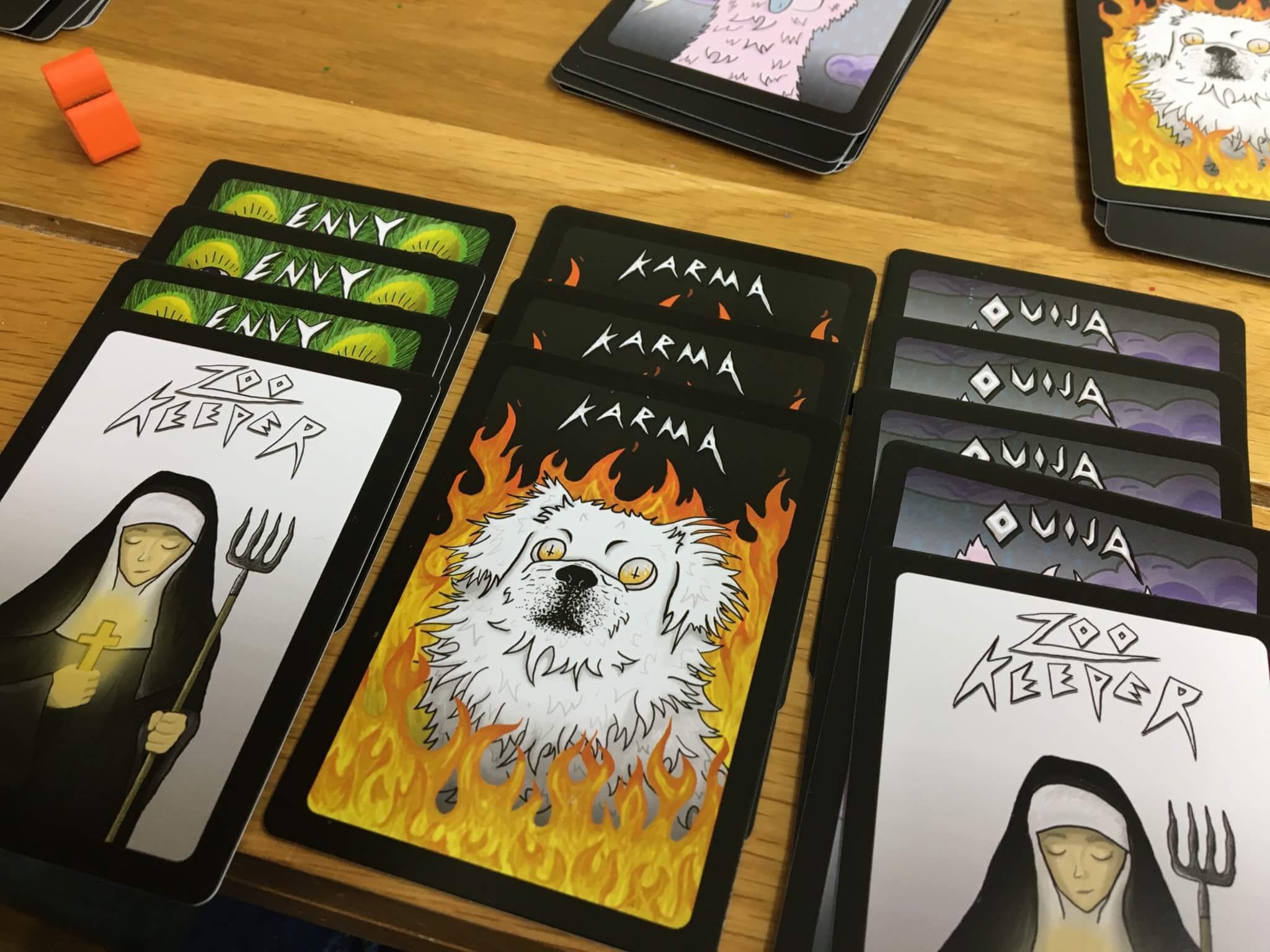Satanimals — naughty nippers
Sometimes it seems that games of a similar theme come in runs. I assume this is because of a particular theme across popular culture, but I’ve never been able to put my finger on it. One theme that we’ve seen a lot of in board gaming recently is that of small box games dealing with the occult, with previous reviews for Crazy Cultists, The Blessed Dark and Banishment. Adding to this run is the subject of today’s review; Satanimals, which tasks the players with operating a zoo filled with, um, Satanimals!
Despite the way that I’ve set it up here, Satanimals is very abstract and very simple, making it more of a set collection and take that game than one which actually simulates the operation of a zoo or similar. The game is made up entirely of cards, of which there are over a hundred. Satanimals plays between two and four players, and in my opinion it is by far at its best when you play the full complement.

Set up is generally simple; the master deck is built with a certain number of cards from each of the five Satanimal sets (Envy, Sloth, Lucifer, Karma, Ouija) and then added to a specific number of Zookeeper and Visitor cards. The number of each card to add to the main deck is dependent upon the player count, with a four player game using all the cards from every deck. These cards are then shuffled, which is a slight problem because with so many cards, it can be hard to do so effectively.
Once the sorting and shuffling is done, three cards will be dealt to each player, except the randomly chosen first player who will receive only one. The remainder of the deck is then dealt evenly into nine piles that are arranged in a three by three grid. Finally, the players are each dealt a secret Main Attraction card, which shows one of the Satanimal suits and allows that player to score bonus points at the end of the game. A couple of wooden tokens are placed to one side, which I’ll explain later.
On their turn, a player must first take three of the cards from the display (which is called a queue in the game.) These three cards must be taken from a straight line, either horizontally, vertically or diagonally. Once done, the player must then take two actions from the following options; place a set of Satanimals in their zoo, place a Zookeeper on top of an existing pile of Satanamals, or use one of the two Visitor actions.

A single Visitor can be sacrificed (discarded) in order to allow the player making the sacrifice to ask another player to give up a specific breed of Satanimal and pass it to them — which they must do, if they have one.) Sacrificing two visitors (or three in a two player game) allows the sacrificing player to destroy one Satanimal that has already been placed into a set by another player — or destroy the Zookeeper on top of them if there is one.
The purpose of creating these sets of Satanimals is linked to end game scoring, as you might expect, and the player who ultimately scores the most is the winner. The thing with each set of Satanimals though, is that once you place a set of one breed, you can never then place another set of the same. Each card in a set is worth one point, plus a point for each card on top of it, so a stack of three Envy cards is worth six points (three plus two, plus one, for the bottom, middle and top card respectively.)
If a player ever completes their zoo (by placing one stack for each breed of Satanimal) then they will take the Zoo Complete token, gaining them a further two bonus points. The second token, known as The Eternal Flame, can be taken by any player who takes three identical cards from the queue when they draw up. This token can move between players during a game, with three bonus points being awarded to whoever holds it at the end.

Satanimals is a very fast paced game and despite the large number of cards that it features, it can be over in about ten or fifteen minutes if the players act fast. Should one or more decks in the queue run out, players must still draw three cards (and the rules don’t indicate that the rules on drawing in a straight line change) so things only get trickier as the game goes on.
It’s also quite difficult to bring to life in words just how interactive Satanimals is. From the actions available to each player after drawing their three cards, I’d say that three turns out of four involve attacking one of the other players with a Visitor card in some way. Imagine that each player is watching closely and knows what the other players have just drawn, and can therefore steal cards that they know the other player is holding.
This constant threat means that the pressure to drop cards onto the table as a set is ever present, yet a stack of three cards is worth so much less than four, and just a ton less points than a five or even six card set. Each Satanimal in a set that matches the Main Attraction card a player was dealt is worth a further point, so again, players will want to focus on those animals, but can’t be too obvious about doing so.

Satanimals is fun at all player counts, but especially so at four. At two it is a little bit less exciting and unpredictable, whilst at three, I found often that at least one player felt unfairly victimised by the other two players (whether intentional or not.) If you’re looking for a simple to learn, highly interactive game that is very suitable for party style play, look no further. The only negative for me is the fiddliness of shuffling such a large number of cards, but this is by no means a major detraction from an otherwise very enjoyable game.
You can purchase Satanimals on Mega Mint Games’ website.

Comments are closed.